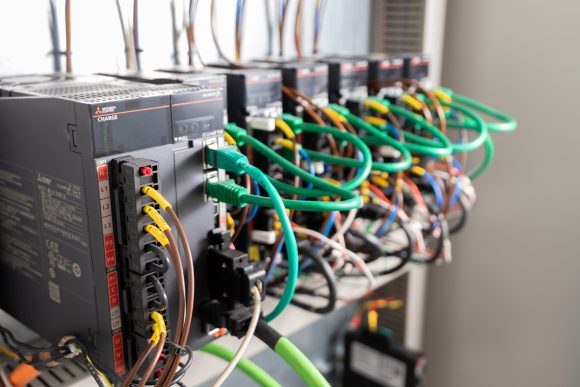The smart factories of the future are built on advanced autonomous systems that perform key tasks with extreme accuracy at high speed. To realize these capabilities, the industrial automation components being utilized, including state-of-the-art motion controllers, need to be able to effectively share data. Selecting devices that incorporate the latest network technologies to share large volumes of data at high speed is essential for machine builders and system integrators committed to delivering value-adding machines to industry players.
The high-speed requirement can be delivered by a new technology known as Time-Sensitive networking (TSN). Machine builders and system integrators need to have highly reliable high-performance networks to support their applications.
Tom Burke, Global Strategic Advisor at the CC-Link Partner Association (CLPA) Americas, looks at what engineers should seek out in industrial automation devices to deliver high-quality motion applications.
Machine builders and system integrators are facing a growing demand for autonomous setups that leverage rotatory equipment or linear actuators to interact with the surrounding environment and perform key tasks. These solutions typically need to offer speed, high encoder resolutions and low tolerances while combining complex, multi-axis systems, where all parts run in sync with extreme repeatability.
Driving advanced data sharing
To accommodate increasingly demanding cycle times while offering exacting performance and maximum uptime, engineers should look for drives and controls that use a network technology that ensures determinism. The recent advances in TSN technology for industrial Ethernet are recognized as the most promising and reliable to offer such capabilities. TSN enables all nodes in a network to be synchronized with high accuracy and is characterized by the ability to schedule and prioritize traffic.
Moreover, deterministic performance needs to be guaranteed even when large volumes of control data are shared, making the network’s available bandwidth another important parameter to include in the evaluation. 100 Mbit/s, or even better: 1 Gbit/s, are ideal to address these needs.
Furthermore, when it comes to sharing data, maximum interconnectivity to generate and share valuable insights with other machine components as well as across the entire plant and enterprise is highly beneficial. Drives need to be able to communicate with all relevant motion components within a system. The ability for machine developers and system integrator to leverage the automation products that are best suited to meet the specifications of their project without having to take into account interoperability issues represents a key asset during development. This can be achieved, for example, by utilizing drives that are compatible with multi-vendor open protocols.
Additionally, devices that can communicate to other elements of an organization across the operational technology (OT) and information technology (IT) domains can enable the transition towards smarter machines, shop floors and fully fledged smart factories. A network technology that enables convergence can also help to facilitate the adoption of artificial intelligence (AI) to further improve predictive control and maintenance, driving profitability. Besides, this capability can simplify network architectures, reducing wiring, as well as their maintenance, ultimately lowering costs.
Ensuring optimal performance
When looking at the mechanical performance of drives in state-of-the-art motion applications, minimizing vibrations is fundamental to delivering efficient operations and quality end products. In addition to improving the service life of the equipment, vibration – or resonance – suppression reduces settling times and, in turn, can support faster cycle times while improving the overall performance of motion applications. The most advanced servo amplifiers are also able to detect vibrations and suppress them. By selecting devices with these features, engineers can deliver robust and accurate setups.
Finally, to create advanced, value-adding solutions, it is important to identify highly efficient components that can minimize the energy requirements of the resulting machine. This is essential to lowering both costs and the environmental footprint of industrial operations.
Leveraging the right technology
An example of a drive technology that addresses all these communications and performance requirements, facilitating the creation of competitive motion applications is Mitsubishi Electric’s MELSERVO MR-J5 series of servos. This is compatible with CC-Link IE TSN network technology, the first open industrial Ethernet that combines gigabit bandwidth with TSN functions. Using this device, machine builders and system integrators can ensure interoperability with a broad range of automation products from a variety of vendors while also ensuring enhanced motion control performance.
In effect, TSN and large bandwidth enable the MR-J5 drives to offer communication cycle times of 31.25µs, a frequency response of 3.5kHz and reach a maximum motor speed of 6,700 r/min. Even more, it is possible to synchronize up to 256 axes with extreme accuracy. Additionally, CC-Link IE TSN ensures that the servos can be connected with a multitude of devices from the OT and IT levels. With the inclusion of Simple Network Management Protocol (SNMP), CC-Link IE TSN supports asset monitoring and management from IT applications, which can access data from the drives.
Finally, the highly energy efficient MR-J5 also features vibration suppression capabilities plus AI-based predictive maintenance functions that detect mechanical component deterioration long before any service requirements arise. As a result, the MR-J5 offers an enhanced service lifespan and uptime as well as optimized maintenance scheduling capabilities for end users, reducing costs and energy use while improving productivity.

